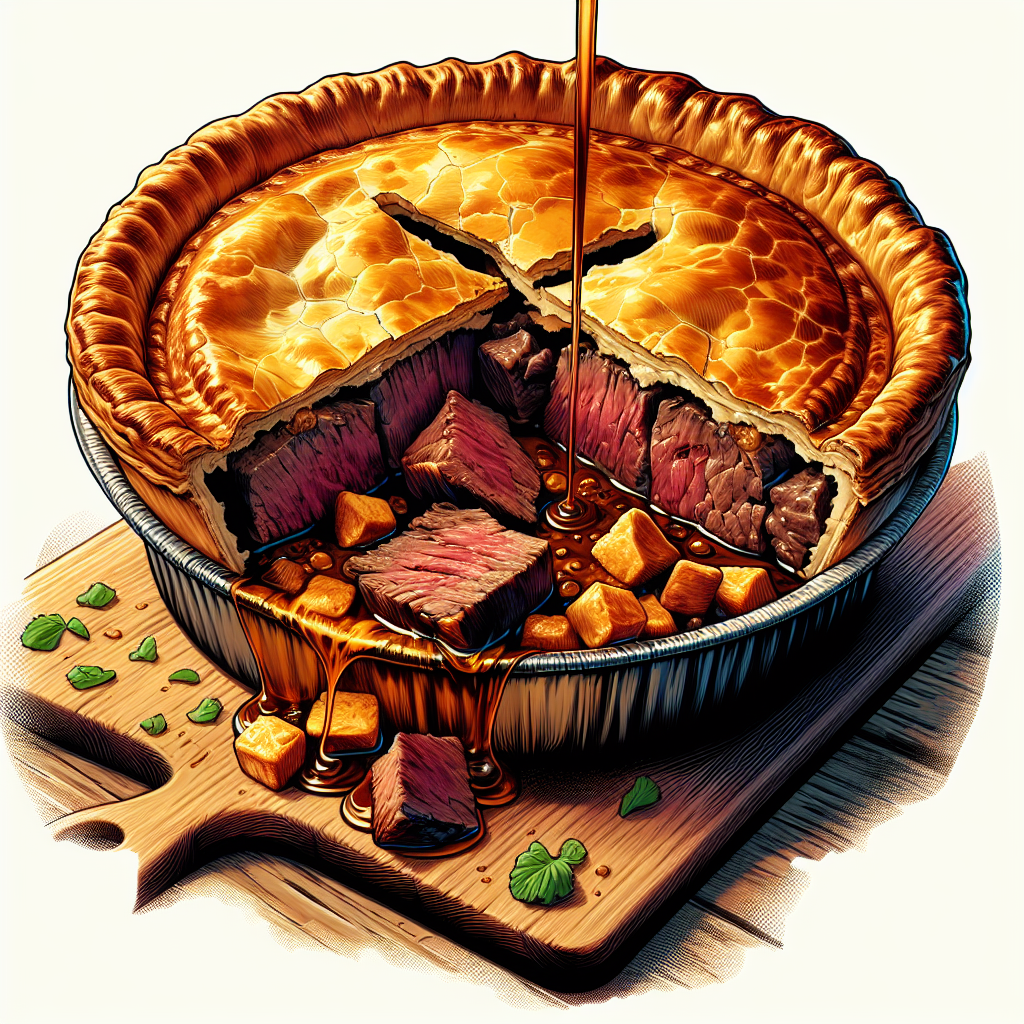Step into the warm and welcoming atmosphere of a traditional British pub, where the scent of savory pies and sweet puddings fills the air, and the clinking of glasses full of frothy ales creates a joyful symphony. At Tastepan.com, we invite you to take a delicious journey into the heart of British pub fare, where centuries-old recipes and timeless traditions blend seamlessly to create a culinary experience like no other. From hearty meat pies to indulgent sticky toffee puddings, this article explores the mouthwatering dishes that have become beloved icons of British cuisine. So grab a pint, pull up a stool, and prepare to savor every bite of this quintessentially British feast.

History of Traditional British Pub Fare
Origin of British pub culture
British pubs have a long-standing history that dates back centuries. The concept of a pub, short for “public house,” was introduced in the Roman era. These establishments were initially created as a place where travelers could rest, socialize, and enjoy a refreshing drink. Over time, pubs became a focal point of the community, serving as gathering places for locals to unwind, share stories, and enjoy a hearty meal.
Evolution of British pub food
In the early days, pub food primarily consisted of simple dishes like bread, cheese, and cured meats. However, as the pub culture flourished, so did the demand for more substantial meals. This led to the development of traditional British pub fare, which includes a diverse array of dishes that are both comforting and satisfying.
Pies: a Staple of British Pub Menus
Types of pies
Pies have long been a staple in British cuisine, and they hold a special place on pub menus. There are various types of pies, each with its own unique characteristics. From savory meat pies to sweet dessert pies, there is something to please every palate. Some popular pie variations include steak and ale pie, chicken and mushroom pie, pork pie, and apple pie.
Popular pie fillings
British pub pies are known for their hearty fillings, which often feature tender meats and flavorful ingredients. For example, steak and ale pie typically includes succulent chunks of beef cooked in rich ale gravy. Chicken and mushroom pie combines tender chicken, earthy mushrooms, and a creamy sauce. The classic pork pie showcases seasoned minced pork encased in a crisp pastry shell. And for those with a sweet tooth, apple pie is a timeless favorite, with its sweet and tangy apple filling.
Traditional pie crusts
The crust is an essential component of any pie, and traditional British pub pies are no exception. The crust can make or break a pie, and the British are known for their skill in creating perfectly flaky and buttery crusts. Shortcrust pastry is commonly used, providing a sturdy yet crumbly texture that complements the filling. Whether it’s a savory or sweet pie, the crust adds an element of indulgence and makes every bite a delight.

Classic British Puddings
Definition and variations of puddings
In the realm of British pub fare, puddings hold a special place. However, it’s important to note that British puddings are quite different from the creamy, gelatinous desserts that may come to mind for others. In the UK, the term “pudding” refers to a broad range of dishes, including both sweet and savory options. They can be boiled, steamed, or baked, resulting in a variety of textures and flavors.
Steamed and baked puddings
Steamed and baked puddings are at the heart of British pudding tradition. Steamed puddings are created by encasing a mixture of ingredients in a suet-based dough and cooking it by steaming. The resulting pudding is moist, dense, and rich in flavor. Baked puddings, on the other hand, are prepared by baking a batter or dough mixture until it forms a soft, sponge-like texture. Both methods result in comforting and satisfying puddings that are perfect for a cozy pub meal.
Common pudding flavors
When it comes to British puddings, there is no shortage of delightful flavors to explore. From the classic sticky toffee pudding to the comforting spotted dick, the range of flavors is diverse and tantalizing. Other popular pudding flavors include treacle pudding, bread and butter pudding, and summer fruit pudding. Each pudding offers a unique combination of ingredients and flavors, making them a quintessential part of any traditional British pub menu.
The Role of Ales in British Pub Culture
Ales vs. lagers
When it comes to beer, ales and lagers are the two main categories. While lagers are known for their crisp and lighter flavors, ales boast a richer and more complex taste profile. In British pub culture, ales have a prominent role, with their robust flavors and long history. Ale brewing has been a part of British tradition for centuries, making it a cherished aspect of pub culture.
Traditional British ale styles
British ales come in a variety of styles, each with its own distinctive characteristics. Bitters, milds, and stouts are among the most popular. Bitters are known for their balanced bitterness and malty backbone, making them a favorite among beer enthusiasts. Milds, as the name suggests, are milder in flavor but still offer a delightful combination of maltiness and hop character. Stouts, with their dark and roasted flavors, provide a robust and satisfying drinking experience.
Popular British ale brands
British pubs pride themselves on offering a wide selection of ales from various breweries. Some popular British ale brands include Fuller’s, Young’s, and Adnams. These breweries have a rich history and are renowned for their commitment to quality and craftsmanship. Whether you prefer a hop-forward bitter or a smooth and creamy stout, you can always find a British ale that suits your taste at a traditional pub.

Traditional British Pub Snacks
Scotch eggs
One iconic British pub snack is the Scotch egg. Originating in England, this savory treat consists of a hard-boiled egg wrapped in sausage meat, coated in breadcrumbs, and deep-fried until golden brown. It provides a satisfying combination of textures and flavors, with the crispy exterior giving way to a luscious egg yolk and flavorful sausage.
Pork pies
Pork pies are another beloved British pub snack. These individual-sized pies are filled with seasoned minced pork, surrounded by a crisp pastry shell. They are often enjoyed cold, making them a convenient and tasty option while enjoying a pint at the pub. Pork pies can be found in various sizes, ranging from bite-sized nibbles to larger pies perfect for sharing.
Pickled onions and gherkins
No British pub experience would be complete without some pickled delights. Pickled onions and gherkins are commonly served as accompaniments to ales and other pub beverages. These tangy and crunchy treats add a refreshing contrast to the rich and savory flavors of traditional pub fare. They serve as palate cleansers, ensuring every bite and sip is thoroughly enjoyed.
Sunday Roast: A British Pub Tradition
Components of a Sunday roast
The Sunday roast is a cherished British pub tradition that brings families and friends together. It typically consists of a roasted meat, such as beef, lamb, or chicken, accompanied by a variety of vegetables. The star of the show is the meat, which is cooked to perfection, juicy and tender. Accompanying the meat are roast potatoes, Yorkshire puddings, seasonal vegetables, and a rich gravy.
Accompaniments and gravies
The accompaniments and gravies play a crucial role in elevating the Sunday roast experience. Roast potatoes, crispy on the outside and fluffy on the inside, provide a comforting and hearty side dish. Yorkshire puddings, made from a batter of eggs, flour, and milk, are light and airy, perfect for mopping up the rich gravy. The vegetables, which can include carrots, peas, and cauliflower, provide a burst of freshness to complement the meat.
Regional variations of Sunday roast
While the Sunday roast is a beloved tradition throughout the UK, there are also regional variations that reflect the local culinary heritage. For example, in Yorkshire, a Yorkshire pudding is often served larger and filled with gravy and sausages, creating a dish called “Toad in the Hole.” In Scotland, the Sunday roast may feature haggis, a traditional Scottish dish made from sheep’s offal, suet, and spices. Each region has its own unique twist on the Sunday roast, adding to the rich tapestry of British pub fare.
Fish and Chips: A British Takeaway Classic
Origin of fish and chips
Fish and chips are an iconic British takeaway classic that has deep roots in the country’s culinary history. It is believed that the concept of frying fish in batter was introduced to Britain by Jewish immigrants in the 17th century. The addition of fried potatoes, known as chips, completed the perfect combination. Fish and chips quickly became a popular and affordable meal enjoyed by people from all walks of life.
Traditional fish used
When it comes to fish and chips, the traditional choice of fish is cod or haddock. These white fish varieties have a delicate flavor and a firm, flaky texture, making them ideal for frying. However, other types of fish, such as plaice and sole, are also commonly used. The fish is typically coated in a light and crispy batter, ensuring a delightful crunch with every bite.
Mushy peas and tartar sauce
Fish and chips are often accompanied by two classic condiments: mushy peas and tartar sauce. Mushy peas are made by boiling dried marrowfat peas until they become soft and mushy. They are seasoned with salt and pepper, adding a touch of sweetness and vibrancy to the dish. Tartar sauce, a creamy and tangy mayonnaise-based sauce, provides a zesty and refreshing contrast to the rich flavors of the fried fish and chips.
Full English Breakfast: A Hearty Pub Morning Meal
Components of a full English breakfast
A full English breakfast, also known as a fry-up, is a hearty and indulgent morning meal often enjoyed at British pubs. It typically includes a combination of the following elements: fried eggs, bacon, sausage, black pudding, baked beans, grilled tomatoes, mushrooms, and toast. This combination of savory and hearty components provides a satisfying start to the day.
Black pudding and baked beans
Two notable components of a full English breakfast are black pudding and baked beans. Black pudding, also known as blood pudding, is a type of sausage made from pork blood and seasoned with various herbs and spices. It has a distinct flavor and adds richness to the breakfast ensemble. Baked beans, a staple in British cuisine, bring sweetness and a touch of comfort to the plate.
Accompaniments like toast and tea
To complete the full English breakfast experience, toast and a cup of tea are often served. The toast provides a crunchy element to contrast with the tender components of the meal, while a cup of tea adds warmth and a refreshing sip to complement the flavors. This hearty breakfast is the perfect way to fuel up for a busy day or to indulge in a leisurely morning at the pub.
Ploughman’s Lunch: A Rustic Pub Delight
Traditional ploughman’s lunch ingredients
Ploughman’s lunch is a quintessential British pub dish that showcases the rustic flavors of the countryside. It typically consists of a selection of ingredients that can vary depending on the region and personal preferences. Common components include a variety of cheeses, pickles, cold meats, crusty bread, butter, and salad. The combination of these ingredients provides a satisfying and well-rounded meal.
Cheeses, pickles, and bread
Central to the ploughman’s lunch are the cheeses, pickles, and bread. Traditional British cheeses such as cheddar, Stilton, and Red Leicester are commonly featured. These cheeses offer a range of flavors and textures, from sharp and tangy to creamy and nutty. Accompanying the cheese is a selection of pickles, such as branston pickle, pickled onions, and chutneys, which add a delightful tang and contrast to the richness of the cheese. All these delicious elements are served with crusty bread and butter, providing the perfect vehicle for enjoying the flavors of the ploughman’s lunch.
Serving and variations
Ploughman’s lunch is often served as a cold dish, making it a refreshing option on a warm day or as a light meal. It can be found in pubs throughout the UK, and each establishment may have its own variations and additions. Some versions may include slices of ham or roast beef, hard-boiled eggs, or even a side of coleslaw. The flexibility of the ploughman’s lunch allows for creativity and ensures that everyone can enjoy their own unique combination of flavors.
Conclusion
Traditional British pub fare encompasses a wide range of dishes, each with its own unique history and flavors. From the heartiness of pies to the indulgence of puddings, the comforting and satisfying nature of these dishes has made them an integral part of British culinary heritage. Ales and pub snacks add to the overall experience, providing delicious accompaniments to the main courses. Whether it’s a Sunday roast, fish and chips, a full English breakfast, or a ploughman’s lunch, traditional British pub fare offers a taste of history and a memorable dining experience. So next time you visit a British pub, be sure to indulge in these time-honored dishes and savor the flavors that have been enjoyed by generations. Cheers!

